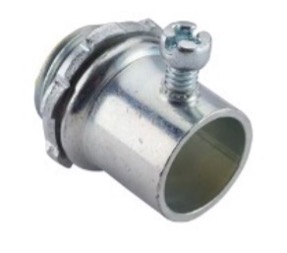What Is the Production Process of EMT Connector?
EMT connectors are essential components in electrical conduit systems. They are used to connect EMT (Electrical Metallic Tubing) conduits to electrical boxes or enclosures securely, ensuring a safe and efficient electrical installation. But have you ever wondered how EMT connectors are made? In this article, we’ll walk you through the complete production process of EMT connectors, from raw materials to finished products.
What Is an EMT Connector?
Before diving into the production process, let’s briefly define what an EMT connector is. An EMT connector is a metal fitting, usually made from steel, zinc, or aluminum, used to connect EMT conduit to electrical enclosures. It ensures proper grounding and mechanical protection for wiring systems in residential, commercial, and industrial applications.
Step-by-Step Production Process of EMT Connector
1. Material Selection and Preparation
The first step is choosing the right material. Common materials include:
Zinc (die-cast)
Steel (galvanized or electroplated)
Aluminum
The raw material is cut or shaped into billets or sheets depending on the specific manufacturing method.
2. Casting or Stamping
There are typically two main manufacturing methods:
Die Casting: For zinc or aluminum connectors. The molten metal is injected into precision molds to form the connector body.
Stamping and Forming: For steel connectors. Steel sheets are stamped and formed using high-speed press machines into the required shapes.
3. Machining and Threading
After forming the basic shape, precision machining is done to:
Smooth the internal and external surfaces
Add threading (for threaded connectors)
Create openings for screws or grounding lugs
This ensures proper fit and function during installation.
4. Surface Treatment
To prevent corrosion and enhance durability, the EMT connectors undergo surface treatment such as:
Electroplating (Zinc Coating)
Hot-dip Galvanizing
Powder Coating (optional)
This step is especially important for outdoor or industrial applications.
5. Assembly
Some EMT connectors consist of multiple parts:
Locknuts
Compression Rings
Screws
These components are assembled either manually or automatically depending on the production scale.
6. Quality Inspection
Each batch undergoes rigorous quality control procedures:
Size and tolerance check
Thread accuracy testing
Tensile strength and torque testing
Salt spray test for corrosion resistance
This ensures that all EMT connectors meet UL, CE, or other international standards.
7. Packaging and Shipping
Finally, the finished connectors are packed in cartons or boxes with clear labeling, ready to be shipped to customers worldwide.
Why Is a High-Quality EMT Connector Important?
Using a well-manufactured EMT connector guarantees:
Electrical safety and grounding reliability
Long-lasting performance in harsh environments
Compliance with local and international codes
Easy installation with reduced labor time
Frequently Asked Questions
Q1: What sizes are available for EMT connectors?
A: EMT connectors come in standard sizes such as ½", ¾", 1", 1-¼", 1-½", and 2".
Q2: Are your EMT connectors CE certified?
A: Yes, our connectors comply with all relevant international standards, including CE.
Q3: Can you customize EMT connectors for specific applications?
A: Absolutely. We offer OEM & ODM services to meet unique customer requirements.
Conclusion
The production of EMT connectors is a precise, multi-step process that requires advanced equipment, skilled labor, and strict quality control. By understanding how EMT connectors are made, you can better appreciate their role in modern electrical systems. If you're looking for a reliable EMT connector manufacturer, our company provides high-quality, certified products tailored to your needs.

